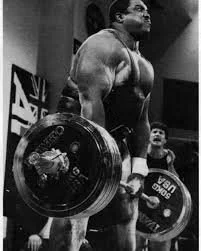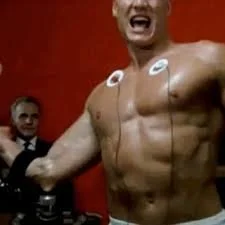Rocky vs. Drago II. Who Ya’ Rooting for in 2025?
OD Wilson was the largest human I have ever met. He was, officially, 6’6” and 420 pounds, but that doesn’t really capture how massive he really was. OD was a “strongman.” He pulled semi trucks with his neck; flipped over cars with his arms. He could lift superhuman amounts of weight off the ground and over his head (his combined squat, deadlift and bench press of 2425 pounds was, at the time, a world record). In 1990, he finished second in the World’s Strongest Man competition (he was in first place until the very end of the competition, when he faltered in the final event, a 200 meter sprint with 220 pounds on his back).
There were two big things on his mind when I met him to interview him for a story a few months after WSM. First, he wanted to stomp on allegations that he was using anabolic steroids to help him accomplish his feats.
Imagine Michelangelo was given a 430 pound slab of marble and chipped away 10 pounds. You’d have OD Wilson.
“What’s the point,” he said, “If you have to use drugs to do it? I want to do it clean.”
But the second thing he wanted to make clear was that he wanted to be THE World’s Strongest Man (“I will win. O.D. will win.”) It was just a matter he said, of working a little harder.
A few months after the interview I got word that OD Wilson had died of a heart attack. He was 37. The conclusion of those in the weightlifting world: he’d given in to temptation; the heart attack was a side effect of his steroid use.
********
For as long as humans have participated in games, we’ve had a fascination with the outer limits of achievement. The motto of the Olympic Games -- “faster, higher, stronger” – reflects that, and every four years, the Games promise to reveal to us who’s fastest, highest and strongest.
But over the past century, we’ve always had some groundrules in place. In the 1924 Summer Olympics in Paris, the question was whether it was fair for athletes to have professional coaches. That question was one of the central plot lines of the Academy Award-winning movie, Chariots of Fire, which I watched again this week.
The movie version of Harold Abrahams defends his decision to use a coach in Chariots of Fire (photo capture from video).
In the movie, British sprinter Harold Abrahams is hauled before the dean of his college at Cambridge for an inquisition. The charge? His deans think it is unsporting that Harold has hired a professional coach to improve his times. “Your aim is to win at all costs?” the Master of Caius College asks. “Not at all costs,” replies Abraham. “I aim to win within the rules, Perhaps you would prefer I play the gentleman and lost?”
With the benefit of professional coaching, the real-life Harold Abrahams won the 100 meter dash in 1924.
These days the argument sounds quaint.
Of course an athlete should be allowed to get professional coaching. Of course the best athletes should be paid for their dedication. And… of course an athlete should be able to use carbon fiber poles to vault higher, graphite racquets to hit tennis balls harder, computer analytics to predict where a baseball player is most likely to hit the ball, springier shoes to run faster, better nutrition to lift more.
But there’s one place we haven’t been willing to go. We draw the line at performance-enhancing drugs: it’s not fair, we say, to juice.
Lance Armstrong? Forget those Tour de France victories. Barry Bonds, Mark McGwire, Sammy Sosa? Their homerun records get an asterisk. Jannik Sinner used a banned substance? Suspend him. When Russian athletes were found to be the beneficiaries of what the World Anti-Doping Agency (WADA) described as “state-sponsored doping,” the entire nation was slapped with a four-year ban.
And those are just the highest profile cases. A Wikipedia page lists every athlete found guilty of doping. I counted 131 cases – and that’s just those whose last name begins with “A.” The infractions come in every sport you can imagine, and some you might not – drag racing, beach volleyball, race walking, ski jumping, mountain biking, field hockey. There are at least six cases of doping in badminton.
In 2020, four-time African badminton champion Foo Kune of Mauritius was banned for two years for doping. She claimed the positive test came after drinking contaminated water. Et tu, badminton?
There’s been some tinkering with the details of drug testing over the years. Which substances in what quantities? How often to test? What are the penalties? But it’s only recently that the notion of drug testing itself has been seriously challenged by big names with big money. Last year a group of investors, including Peter Thiel and Donald Trump Jr., founded the Enhanced Games, essentially a new version of the Olympics that throws drug protocols out the window (they hope to make money selling testosterone supplements on their website).
They’re calling the question: if we really want to know how fast, how jumpy, and how strong humans could be, why shouldn’t athletes be allowed to use any means possible to enhance their performance?
A recent article in the Wall Street Journal examines what happened when two-time Olympian Greek swimmer Kristian Gkolomeev, a 50-meter specialist who finished 5th in the 2024 Games, decided to give up on his career as a drug-tested swimmer and join the Enhanced team. He underwent a variety of tests to learn everything he could about himself – how quickly he absorbed oxygen, how much his lungs could hold, the capacity of his heart – and discovered he had plenty of room to improve. Then, working with doctors, he began mixing steroid hormones like testosterone, metabolic regulators and growth hormone. Immediately, he discovered he could work out harder and recover quicker. Two months later, he had gained 13 pounds of muscle. Then, in Greensboro, NC this past February, fully juiced and wearing an extra-floaty swimsuit (banned by official rules), Gkolomeev jumped into the pool at a time trial and swam 50 meters faster than any human in history. And while no international body will recognize it as a “world record,” Enhanced Games rewarded him with a $1 million bonus.
Kristian Gkolomeev after realizing he’s won $1 million for swimming the fastest 50 meters ever. Almost nobody saw and and no official group will recognize it.
The next big step for Enhanced Games is to broaden their efforts to other sports. At the Enhanced Games in Las Vegas next May, they’ll host competitions on the track (100 meter sprint and hurdles), in the pool (50 and 100 meter freestyle and butterfly) and in the gym (weightlifting’s snatch clean and jerk). WADA has called the competition “dangerous and irresponsible” and has already announced that any athlete, trainer, coach or doctor involved with the Enhanced Games will be banned for life from traditional competitions.
Enhanced has responded with an $800 million lawsuit against the traditional organizations, arguing they are violating anti-trust laws. The head of the organization, Aron D’Souza, a philosophy Ph.D., says letting drugs into sports can be done safely and will help us learn critical information about how to improve human performance. What they will discover, D’Souza says is how to “bring advanced age into existence. Who would want to be a Human 1.0 when you can exist in the world of Human 2.0?”
So the question is whether we, the fans, are ready for the Games run by the people planning Human 2.0.
“In 10 years time,” says D’Souza, “I imagine we will not even be talking about pharmacological enhancements. This is going to be so commonplace, it’s going to be like Ozempic. Everyone’s going to be doing it.”
********
In 1985 the US conducted a giant, unofficial focus group on this question when Rocky IV came out. The movie told the story of undersized underdog Rocky Balboa and his championship fight with Russian superman Ivan Drago.
Using cutting edge technology and “supplements,” Ivan Drago became an early prototype of “Human 2.0.” “Whatever he hits, he destroys.”
Rocky moves to Siberia to prepare for the fight. In the mandatory Rocky training montage, we see him getting ready by running through snowbanks in sweatpants, chopping down very large trees, lifting bags of boulders on a pulley, pulling Paulie in a dog sled and helpfully lifting one of his Siberian neighbors sleighs out of the ice. Horses snort in shock; KGB spies shake their heads in amazement. Meanwhile, Drago trains, indoors and in spandex, every inch of flesh covered with sensors, every punch measured by some sort of 80’s computer. And then, in case we were still on the fence over who to root for, we see him getting needlefuls of some sort of clearly evil juice in his arm.
In 1985 we screamed for Rocky. We hissed at Drago. Rocky (spoiler alert) won with good old-fashioned pluck.
Forty years later, Enhanced Games is betting we’re ready to cheer for Drago.
Notes:
A summary of OD Wilson’s career – note estimates of his height range from 6’5” to 6’8” and weight from 400-450 – I am using a height and weight he quoted in interviews: https://barbend.com/od-wilson/
Russian athletes’ 4-year ban: https://www.politico.eu/article/russia-olympics-ban-wada/
Wikipedia doping list: https://en.wikipedia.org/wiki/List_of_doping_cases_in_sport_(A)
Wall Street Journal article on Enhanced Games: https://www.wsj.com/sports/enhanced-games-swimmer-world-record-doping-c415384b?gaa_at=eafs&gaa_n=AWEtsqcMDiyPJbr-OKInzE3yl_UklwfI-Dlrmj70ao8hWhG4yIaOhsq0VViXkR6OxTA%3D&gaa_ts=69054545&gaa_sig=6MipyCuZQyHToEI1XsY2j2vYUeM3Bb2FPdaYLwZg4bSWaC11aci4Jwk9iZwjbk8B7zFKUfFD_VNosKbU_pqJmQ%3D%3D
Enhanced’s revenue model calls for significant sales of supplements through their website: https://www.enhanced.com/products
Watch Kristian Gkolomeev’s world’s-fastest 50 meter swim – he took no breaths: https://www.youtube.com/watch?v=rK6iio-usy0
The two Rocky IV training montages are helpfully combined in this video.: https://www.youtube.com/watch?v=A_hLdPRsssE





